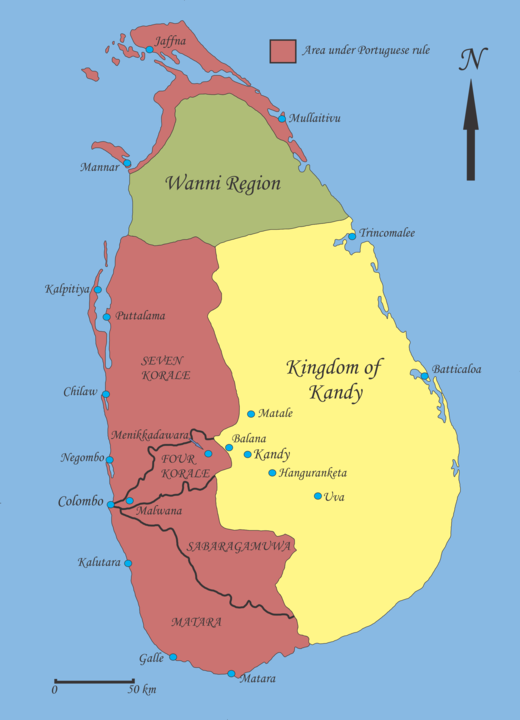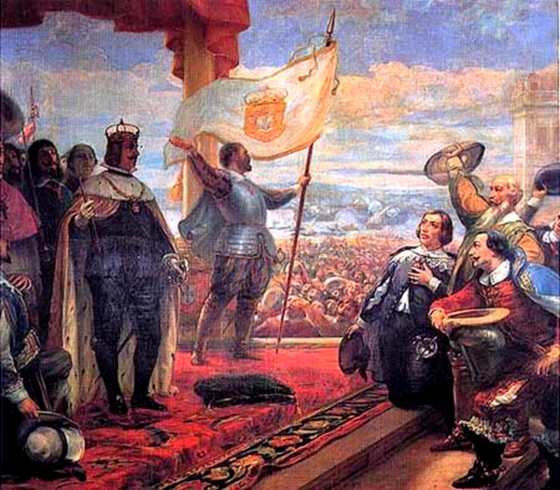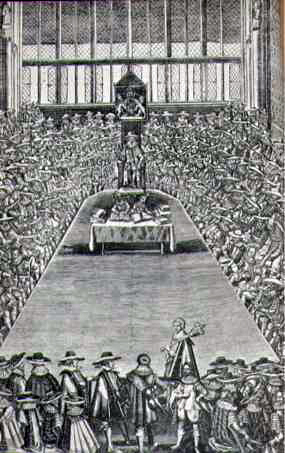1640 CE was a huge year in the continuing evolution of Western imperialism. Most of today’s bulletin will deal with the two items noted in the headline. But first, a few very short takes:
- In February, Ottoman Sultan Murad IV died and was succeeded by his 25-year-old younger brother Ibrahim. Murad had had all his brothers killed upon his accession in 1623 but had saved Ibrahim, though he had him confined in a cage in the palace harem which affected his sanity. Both Murad and Ibrahim seem to have been weird, cruel, and tempestuous so I conclude the Ottoman empire was surviving in those decades thanks only to the professional, janissary-based class of bureaucrats headed by the Grand Vizier. In February 1640, the GV was Kemankeş Kara Mustafa Pasha (“Black Mustafa Pasha, the Archer, the Courageous”.)
- In March, The Dutch VOC troops in Ceylon worked with the King of Kandy to capture the port city of Galle from Portugal. Galle is on the southwest tip of today’s Sri Lanka. English-WP says: “With this victory the Dutch gained access to a large port which they later used as a convenient naval base to attack Goa and other South Indian Portuguese defenses. They also gained access to the Sri Lankan cinnamon trade and gained a permanent foothold on the island.”
- In July, a transported African in Virginia called (by the English colonists) “John Punch” received a sentence from the Virginia Governor’s Council, for the “crime” of having run away to Maryland, of perpetual servitude “for the time of his natural life.” It was not known whether, prior to that sentencing he was working on the basis of a time-limited indenture, or was actually already in some form of enslavement. When he ran away, he did so alongside two indentured “White” men, a Dutchman and a Scot. For the same “crime”, their sentence was merely to have their existing term of indenture extended by a year. That sentence was the first formal ruling by the Governor’s Council on matters of race and servitude and laid the basis for the race and enslavement laws the colony would introduce within the next couple of decades.
Portugal regains its independence from Spain
You will recall that back in 1580, Portugal had suffered a dire succession crisis, after which King Philip II of Spain took over the crown there in addition to his own, forming the “Iberian Union”. Portugal still had a degree of autonomy, being ruled by a “Council of Portugal” that mirrored the “Council of Castile” and “Council of Aragon” that existed within Spain, though many aspects of rule including taxation and finances seem to have been pretty centralized.
At the global level, the Iberian Union brought together under one roof two colonial trading/raiding systems that had some notable differences. Portugal had by far the older colonial system, having established armed trading/raiding posts on the West-Moroccan coast and down the whole of West Africa back in the 15th century CE. And then in the early 16th century it had rapidly built up the network of armed trading/raiding posts all around the Indian Ocean that took it to the Arabian Peninsula, to Goa and the whole of the Indian coast, to Ceylon (as noted above), to the East Indies, China, etc.
By and large, maintenance of most of the Portuguese empire’s coastal trading/raiding posts did not involve exerting control over very much of their hinterland. By contrast, once the Spanish conquistadors had reached the mainland of Central and South America in the early 16th century, they pushed deep into the interiors of those areas in order to control and exploit territory, resources, and the indigenous inhabitants. Portugal emulated that form of colony-building only in Brazil, later in the 16th century.
By 1640, Spain was already in many ways a declining power. The annual average of total (both-way) trade with its its empire, which had been 41,400 tonneladas of goods in the early 1600s, had declined to 18,350. (A tonelada is roughly 3 cubic meters; the source there is S.G. Payne’s A History of Spain and Portugal, vol.1, p.296.) Moreover, the obsession that Spain’s earlier Habsburg rulers had harbored with exerting control over as much of continental Europe as possible, and especially with rolling back and crushing Protestantism as much as possible, was still being actively pursued by King Philip IV. He was still enmeshed in the land and sea war against the protestant Netherlands as well as in the war deep in continental Europe that had started in 1618 and would come to an end– after massive devastation of much of Germany and central Europe– only in 1648 (the Thirty Years War.)
Remember, too, how Spain’s navy had a big defeat at the hands of the Netherlands navy just last year…
In 1640, Philip and his advisors had thought up the strange idea of trying to engage the often balky residents of Catalonia more deeply in the European struggle by routing one of his big war campaigns through Catalonia. That backfired badly, and the Catalans rose in a broad open revolt against the prospect that Spanish military men would be billeted in large numbers on them. The Catalan rebellion only increased the massive costs Philip’s wars were imposing on the Spanish treasury…
I’ll let this page on English-WP take it from here:
Several other problems also damaged Portuguese support of their union with Spain. One of these was certainly the pressure from the center, especially from [Philip IV’s key henchman] the Count-Duke of Olivares, towards uniformity and sharing the financial and military burden of Castile’s wars in Europe. However, the Portuguese were hardly inclined to help with that, as Spain had failed to prevent the Dutch occupation of several of Portugal’s colonial holdings, despite the fact that both the Portuguese and the Spanish were nominally under the same crown.
This situation culminated in a revolution by the nobility and high bourgeoisie [of Portugal] on December 1, 1640, 60 years after the crowning of Philip I. This revolution, while foreseeable, was most immediately sparked by a popular Catalan Revolt against the Crown. The plot was planned by Antão Vaz de Almada, Miguel de Almeida and João Pinto Ribeiro. They, together with several associates, known as the Forty Conspirators, took advantage of the fact that the Castilian troops were occupied in the other side of the peninsula. The rebels killed Secretary of State Miguel de Vasconcelos and imprisoned the king’s cousin, the Duchess of Mantua, who had governed Portugal in his name. The moment was well chosen, as Philip’s troops were at the time fighting the Thirty Years’ War in addition to the previously mentioned revolution in Catalonia.
The support of the people became apparent almost immediately and soon John, 8th Duke of Braganza, was acclaimed King of Portugal throughout the country as John IV.
Within the peninsula, King Philip wanted to contest and end the secession, and there were skirmishes of varying severity along Portugal’s long-established border with Spain for the next 28 years. (In several of those, Portugal received support from England. In 1662, King John would even marry his daughter Catherine to England’s King Charles II, and she took with her a rich “dowry” of colonial possessions in several parts of the world.)
King Philip’s successor Spain’s King Charles II would finally recognize Portugal’s independence and sign a peace treaty with it, in 1668.
At the global level, the (re-)separation of Spain and Portugal would have broad repercussions. The colonial raiding/trading networks that Portugal had earlier built in the Indian Ocean had already been badly eroded by the Dutch and English, and newly independent Portugal did little to revive them. The colonizing energies of post-1640 Portugal were directed instead to expanding Portugal’s presence in Brazil as much as possible– while also significantly ramping up its involvement in the transatlantic trade in enslaved Africans.
Turmoil in England and Scotland
Remember how, back in the days of Mary Queen of Scots in the mid-16th century, Scottish opposition to English rule had often taken the form of a Catholic backlash against London’s Protestantism? How times have changed. By 1640, a large amount of Scottish resistance to London’s overlordship came in the form of a harsh, Puritan form of Calvinism, while Catholicism in Scotland was now found only among a few members of the aristocracy and in distant highlands and islands.
Along the way, Scotland had developed its own form of Protestant “kirk” (church). In the Church of England, administrative power was held by bishops appointed by the king– hence, an “Episcopalian” form of governance. But the Calvinists in Scotland had developed a more ground-up form of governance through “Presbyters” elected by minister and elders.
When James I/VI had united the kingdoms of Scotland and England under a single crown in 1603, he had originally wanted to dissolve all the remaining distinctions between the two polities, and he thought uniting their churches would be good first step. Big mistake; and the Scots were able to defeat that first effort. Then, when King Charles I succeeded his dad in 1625, he tried again, proposing a move that the Scots saw as imposing on their kirk both an English-style prayer-book and the dreaded institution of bishops.
In 1638, the church elders in Scotland issued a powerful National Covenant in which they pledged to oppose the English measures, which was taken up with gusto by people throughout Scotland. (The banner image at the top of the page is a painting of the signing of the Covenant in a kirkyard in Edinburgh.)
In 1639, Charles sent an army against Scotland to impose his will on the Covenanters, in what was called the First Bishops’ War. But the Covenanters were able to resist him. He realized that to raise an army big enough to do the job he needed to raise funds– and for that he would need to recall the English parliament that he had dissolved back in 1629.
This parliament started sitting on April 13, 1640. Here‘s what English-WP says about it:
After 11 years of attempting Personal Rule between 1629 and 1640, Charles recalled Parliament in 1640 on the advice of Lord Wentworth, recently created Earl of Strafford [remember him from his disastrous campaign in Ireland a while back?], primarily to obtain money to finance his military struggle with Scotland in the Bishops’ Wars. However, like its predecessors, the new parliament had more interest in redressing perceived grievances occasioned by the royal administration than in voting the King funds to pursue his war against the Scottish Covenanters.
John Pym, MP for Tavistock, quickly emerged as a major figure in debate; his long speech on 17 April expressed the refusal of the House of Commons to vote subsidies unless royal abuses were addressed… A flood of petitions concerning royal abuses were coming up to Parliament from the country. Charles’s attempted offer to cease the levying of ship money did not impress the House.
Annoyed with the resumption of debate on Crown privilege and the violation of Parliamentary privilege by the arrest of the nine members in 1629, and unnerved about an upcoming scheduled debate on the deteriorating situation in Scotland, Charles dissolved Parliament on 5 May 1640, after only three weeks’ sitting.
That one was known as the “Short Parliament.”
In summer 1640, the Scottish Covenanters went on the offensive in the Second Bishops’ War, in which their army pushed deep into northeast England. Unable to resist them, and in a situation in which support for the Covenanters was already wide among the Puritans in England, King Charles was forced to negotiate. This WP page recounts the extraordinary series of events that ensued:
Charles called a meeting of the Great Council of Peers in York, the first time this body had met for a century. The Council declined to assume the functions of Parliament, but did negotiate the treaty with the Covenanters.
Meanwhile, the Scottish army was facing shortages of supply and started collecting moneys from the nearby shires and church properties, as well as from Newcastle itself in order to pay for the continued upkeep of the army. This shortage of supplies did confer a negotiating advantage to the Covenanters though. With incidents of pillaging by soldiers already being reported, the English lords did not want to see the army become a mob living in the area of Newcastle, but Charles could not afford to pay the invaders’ demands without the tax-raising powers of Parliament, making a settlement involving both king and Parliament inevitable. In collaboration with the king’s opponents the Covenanters also refused to withdraw until Charles summoned the English Parliament.
Under the terms of the treaty the Scottish continued to occupy Northumberland and Durham, and were to receive expenses of £850 a day starting from 16 October paid from England, but agreed to a temporary cessation of hostilities. This situation was to continue until a full settlement was agreed. The Scottish Government was also to be reimbursed for its expenses in the war.
These terms were humiliating, but Charles was desperate to stop the Covenanters from taking York and with little support from his peers his options were limited, and he was forced to agree.
Terms were finalised on 16 October, and accepted by Charles on the 28th. Negotiations on the permanent settlement would continue until August 1641, when the Treaty of London was signed.
Charles issued writs for what became known as the Long Parliament, which assembled on 3 November 1640, ending eleven years of Personal Rule. Since the Scots made it clear they would only return home once paid, and would only agree terms with Parliament, Charles was now faced with a body that he could not dissolve at will. During this time the Covenanters used their army’s continued presence in England to strengthen the position of the king’s English opponents.
Over the next few months, Parliament voted to ensure it could not be dissolved without its own consent, imprisoned Archbishop Laud, and executed the Earl of Strafford. Only then did it agree the Treaty of London on 10 August 1641, which agreed to pay the Scots £300,000 to cover the costs of the war. The Covenanters’ army then returned to Scotland, where most of it was disbanded.
Those three measures listed there, that the English parliament adopted in late 1640 and early 1641, were very significant. The first one, in particular, changed the basis of the English political system forever, establishing that never again could a monarch dissolve parliament without its consent. Over the years that followed, parliament would swiftly move, indeed, to dissolving the monarchy itself.







